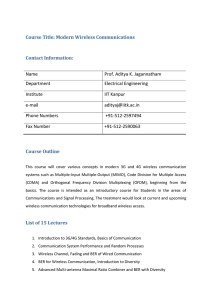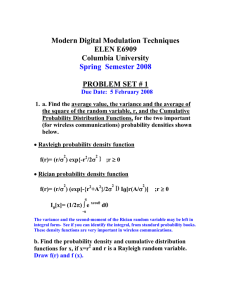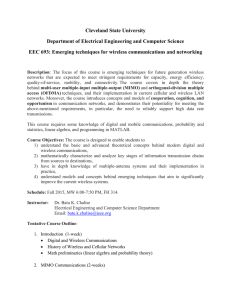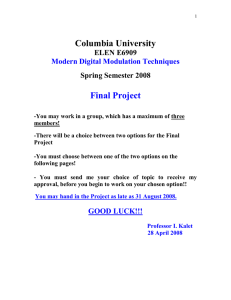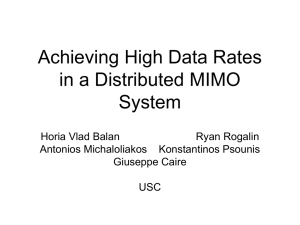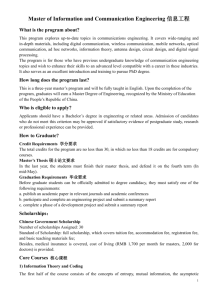Web Site: www.ijaiem.org Email: , Volume 2, Issue 4, April 2013
advertisement
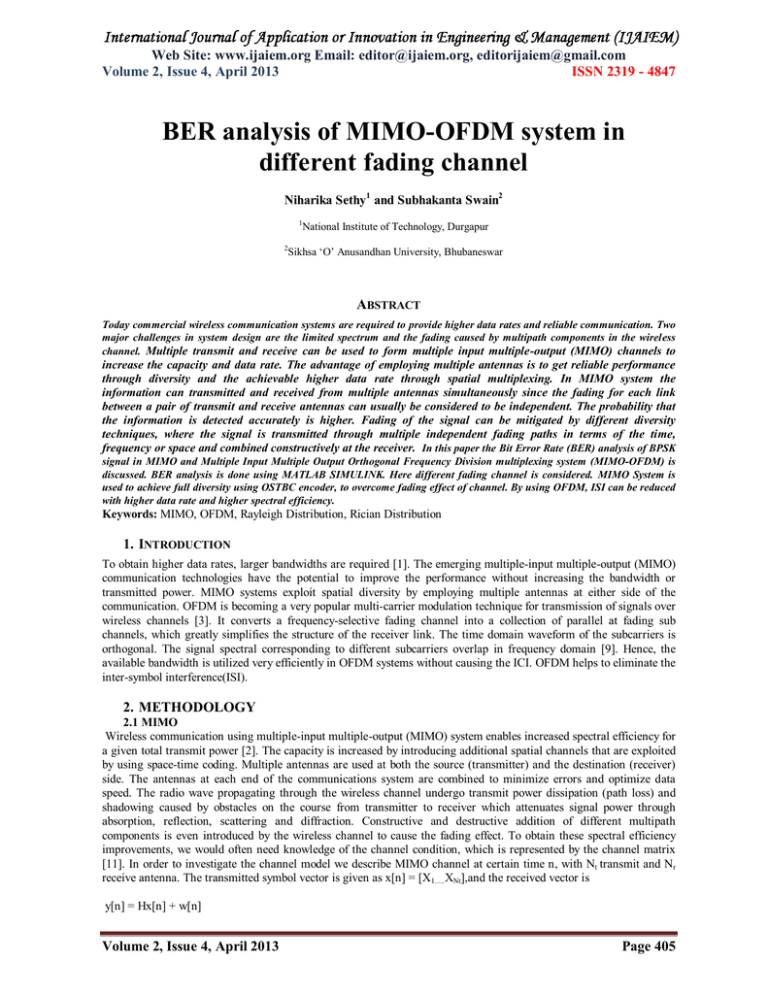
Web Site: www.ijaiem.org Email: editor@ijaiem.org, editorijaiem@gmail.com Volume 2, Issue 4, April 2013 ISSN 2319 - 4847 BER analysis of MIMO-OFDM system in different fading channel Niharika Sethy1 and Subhakanta Swain2 1 National Institute of Technology, Durgapur 2 Sikhsa ‘O’ Anusandhan University, Bhubaneswar ABSTRACT Today commercial wireless communication systems are required to provide higher data rates and reliable communication. Two major challenges in system design are the limited spectrum and the fading caused by multipath components in the wireless channel. Multiple transmit and receive can be used to form multiple input multiple-output (MIMO) channels to increase the capacity and data rate. The advantage of employing multiple antennas is to get reliable performance through diversity and the achievable higher data rate through spatial multiplexing. In MIMO system the information can transmitted and received from multiple antennas simultaneously since the fading for each link between a pair of transmit and receive antennas can usually be considered to be independent. The probability that the information is detected accurately is higher. Fading of the signal can be mitigated by different diversity techniques, where the signal is transmitted through multiple independent fading paths in terms of the time, frequency or space and combined constructively at the receiver. In this paper the Bit Error Rate (BER) analysis of BPSK signal in MIMO and Multiple Input Multiple Output Orthogonal Frequency Division multiplexing system (MIMO-OFDM) is discussed. BER analysis is done using MATLAB SIMULINK. Here different fading channel is considered. MIMO System is used to achieve full diversity using OSTBC encoder, to overcome fading effect of channel. By using OFDM, ISI can be reduced with higher data rate and higher spectral efficiency. Keywords: MIMO, OFDM, Rayleigh Distribution, Rician Distribution 1. INTRODUCTION To obtain higher data rates, larger bandwidths are required [1]. The emerging multiple-input multiple-output (MIMO) communication technologies have the potential to improve the performance without increasing the bandwidth or transmitted power. MIMO systems exploit spatial diversity by employing multiple antennas at either side of the communication. OFDM is becoming a very popular multi-carrier modulation technique for transmission of signals over wireless channels [3]. It converts a frequency-selective fading channel into a collection of parallel at fading sub channels, which greatly simplifies the structure of the receiver link. The time domain waveform of the subcarriers is orthogonal. The signal spectral corresponding to different subcarriers overlap in frequency domain [9]. Hence, the available bandwidth is utilized very efficiently in OFDM systems without causing the ICI. OFDM helps to eliminate the inter-symbol interference(ISI). 2. METHODOLOGY 2.1 MIMO Wireless communication using multiple-input multiple-output (MIMO) system enables increased spectral efficiency for a given total transmit power [2]. The capacity is increased by introducing additional spatial channels that are exploited by using space-time coding. Multiple antennas are used at both the source (transmitter) and the destination (receiver) side. The antennas at each end of the communications system are combined to minimize errors and optimize data speed. The radio wave propagating through the wireless channel undergo transmit power dissipation (path loss) and shadowing caused by obstacles on the course from transmitter to receiver which attenuates signal power through absorption, reflection, scattering and diffraction. Constructive and destructive addition of different multipath components is even introduced by the wireless channel to cause the fading effect. To obtain these spectral efficiency improvements, we would often need knowledge of the channel condition, which is represented by the channel matrix [11]. In order to investigate the channel model we describe MIMO channel at certain time n, with Nt transmit and Nr receive antenna. The transmitted symbol vector is given as x[n] = [X1.....XNt],and the received vector is y[n] = Hx[n] + w[n] Volume 2, Issue 4, April 2013 Page 405 Web Site: www.ijaiem.org Email: editor@ijaiem.org, editorijaiem@gmail.com Volume 2, Issue 4, April 2013 ISSN 2319 - 4847 In, W[n] = [W1....WNr] T represents noise. The channel matrix is H. Here hi,j represents the complex gain from jth transmitting antenna to the ith receiving antenna H 11 . H . . . . . H Nr ,1 H 1, Nt . . . . . . H Nr , Nt The Alamouti space time coding scheme can be used to achieve diversity at the transmitter and receiver [4].The information bits are first modulated using an M-ary modulation scheme. The encoder then takes a block of two modulated symbols s1 and s2 in each encoding operation and gives it to the transmit antennas according to the code matrix given bellow [12]. S1 S S2 S2 S1 2.2 OFDM The basic idea underlying OFDM systems is the division of the available frequency spectrum into several sub carriers. To obtain a high spectral efficiency, the frequency responses of the sub carriers are overlapping and orthogonal [3]. The binary information is first grouped, coded, and mapped according to the modulation in a “signal mapper”. After the guard band is inserted, an N-point inverse discrete-time Fourier transform (IDFT) block transforms the data sequence into time domain. Following the IDFT block, a cyclic extension of time length, chosen to be larger than the expected delay spread, is inserted to avoid inter symbol and inter carrier interferences [10]. At the receiver side, after passing through the analog-to-digital converter (ADC) and removing the CP, the DFT is used to transform the data back to frequency domain. Lastly, the binary information data is obtained back after the demodulation and channel decoding. 2.3 MIMO and OFDM Orthogonal Frequency Division Multiplexing (OFDM) is used for high data rate in wireless communications [1]. OFDM can be used in conjunction with a Multiple-Input Multiple-Output (MIMO) transceiver to increase the diversity gain and the system. The OFDM system effectively provides numerous parallel narrowband channels [4].The Block diagram for MIMO-OFDM is shown in Fig. 1[13]. 2.4 FADING When signal travels from transmitter to receiver due to fading effect of channel, the envelope of received signal follows Rayleigh or Rician distribution. When a there is relative motion between mobile user and base station, the frequency of received signal changes and this phenomenon is called Doppler frequency shift. (a) Doppler Frequency Shift Doppler shift is the random changes that occur in a channel introduced as a result of a mobile user’s mobility or movement [5]. It is the apparent difference in frequency of the received signals from that of the transmitted signals when there is a relative motion between the transmitter and receiver. This Doppler frequency shift is given in d F equation (1), where is is and C is speed of light. F d V COS C (1) (b) Rayleigh Distribution This occurs when the envelope of the received signal follows a Rayleigh distribution. Rayleigh distribution is statistically used to model a faded signal, when there is no dominant LOS path [6]. The envelope of the received signal with Rayleigh distribution has the probability density function (pdf) given by as p r r 2 exp r 2 (2) (c) Rician Distribution Volume 2, Issue 4, April 2013 Page 406 Web Site: www.ijaiem.org Email: editor@ijaiem.org, editorijaiem@gmail.com Volume 2, Issue 4, April 2013 ISSN 2319 - 4847 The Rician distribution used to model a distribution when a strong line of sight component is present along with the weaker components [6]. It has the probability density function (pdf) given by r P s, r 2 exp r 2 2 s 2 2 2 2 I s 0 2 2 (3) Figure 1 Block diagram of MIMO OFDM system 3. RESULT Figure 2 BER perforrmance of BPSK signal in MIMO OFDM system Volume 2, Issue 4, April 2013 Page 407 Web Site: www.ijaiem.org Email: editor@ijaiem.org, editorijaiem@gmail.com Volume 2, Issue 4, April 2013 ISSN 2319 - 4847 Figure 3 BER perforrmance of BPSK signal in MIMO system Figure 4 BER perforrmance comparison of MIMO and MIMO OFDM system 4. DISCUSSION In this paper simulation is done using MATLAB SIMULINK tools. In Fig.2 comparison is done between the BER analysis of MIMOOFDM system in Rayleigh channel and Rician channel (2x2). The BER performance of Rician channel is better than Rayleigh channel. At BER = 0.207 the Rician channel has Eb/No = 15dB but Rayleigh has Eb/No= 25dB. So there is an improvement of 10dB in SNR of Rician channel than Rayleigh channel. In Fig3 BER performance of Rayleigh channel in MIMO system is compared with Rician channel (3x2). Here there is an improvement of of 8dB.In the SNR of Rayleigh channel than Rician channel. In Fig.4 the BER performance of both Rayleigh and Rician channel is given. Volume 2, Issue 4, April 2013 Page 408 Web Site: www.ijaiem.org Email: editor@ijaiem.org, editorijaiem@gmail.com Volume 2, Issue 4, April 2013 ISSN 2319 - 4847 5. C ONCLUSION The BER performance of Rayleigh channel and Rician channel in MIMOOFDM system are same in lower value of Eb/No. But after 8dB there is large difference between BER of Rayleigh and Rician channel. The BER performance of Rayleigh channel in MIMO system is much better than that of Rician channel. After 20dB there is no change in BER performance of Rician channel even if Eb/No increases to 30dB. The BER performance of MIMO system is compared to that of MIMO OFDM system. Here we can observe that the BER performance of MIMO system is better than that of MIMO OFDM system. But as comparison to MIMO system the MIMO OFDM is more spectrally efficient. Reference [1] Andrea Goldsmith, Wireless Communications, Andrea Goldsmith, Stanford University, Cambridge University Press, 2005. [2] A. Sharma, A. Garg, “BER Analysis Based on Transmit and Receive Diversity Techniques in MIMO OFDM System,” International Journal of Electronics & Communication Technology, 3 (1), pp. 58-60, 2012. [3] C. Poongodi, P.Ramya, A. Shanmugam, “BER Analysis of MIMO OFDM System using M-QAM over Rayleigh Fading Channel,” Proceedings of the International Conference on Communication and Computational Intelligence, pp. 284-288, 2010. [4] S. Trivedi, Mohd. S. Raeen, S. Singh pawar, “BER Analysis of MIMO-OFDM System using BPSK Modulation Scheme,” International Journal of Advanced Computer Research, 2 (5), pp. 208-214, 2012. [5] Z.K. Adeyemo, D.O. Akande, F.K. Ojo and H.O. Raji, “Comparative evaluation of fading channel model selection for Mobile wireless transmission system,” International Journal of Wireless & Mobile Networks, 4 (6), pp.127-137, 2012. [6] T. S. Rappaport, Wireless Communications, second edition, Pearson Education Asia, 2002. [7] A. K. Jaiswal, A. Kumar, A.P. Singh, “Performance analysis of mimoofdm system in rayleigh fading channel,” International Journal of Scientific and Research Publications, 2 (5), pp.1- 5, 2012. [8] J. Zhang, Q. Zhao, “Simulation and analysis of mimo-ofdm based simulink,” IEEE, pp. 19-22, 2010. [9] L. Kansal, A. Kansal, K. Singh, “BER Analysis of MIMO-OFDM System Using OSTBC Code Structure for MPSK under Different Fading Channels,” International Journal of Scientific & Engineering Research, 2 (11), pp. 112, 2011. [10] M. Agrawal, Y. Raut, “BER Analysis of MIMO OFDM System for AWGN & Rayleigh Fading Channel,” International Journal of Computer Applications, 34 (9), pp. 33-37, 2011. [11] Shuchi Jani, Shrikrishan Yadav, B. L. Pal, “Analysis of Various Symbol Detection Techniques in Multiple-Input Multiple-Output System (MIMO) ,” Advanced Computing International Journal, 3(2),pp. 93-103, 2012. [12] Muhammad Sana Ullah, Mohammed Jashim Uddin, “Performance Analysis of Wireless MIMO System by Using Alamouti’s Scheme and Maximum Ratio Combining Technique,” International Journal of Advanced Engineering Sciences And Technologies, 8(1),pp. 19-24, 2011. [13] A. Omri and R. Bouallegue, “New Transmission Scheme For MIMO-OFDM System,” International Journal of Next-Generation Networks ,3(1),pp. 11-19, 2011. AUTHOR Niharika Sethy obtained her B.E degree in Electronics and Telecommunication engineering from B.P.U.T, ODISHA. She has 5 years of teaching experience in different Engineering Schools and Colleges. Now she is continuing her Master of Technology in National Institute of Technology, Durgapur, West Bengal .Her area of interest is performance of different Wireless system (MIMO, MIMOOFDM) in presence of Noise, Interference and Fading. Subhakanta Swain received B.Tech from BPUT, Orissa in 2010. And continuing his M.Tech in Sikhsa ‘O’ Anusandhan University, Bhubaneswar, Orissa, India. He has performed research in the areas of Wireless multimedia sensor networks. His core area of research is Priority-based rate control for service differentiation and congestion control in Wireless multimedia sensor networks. Volume 2, Issue 4, April 2013 Page 409

